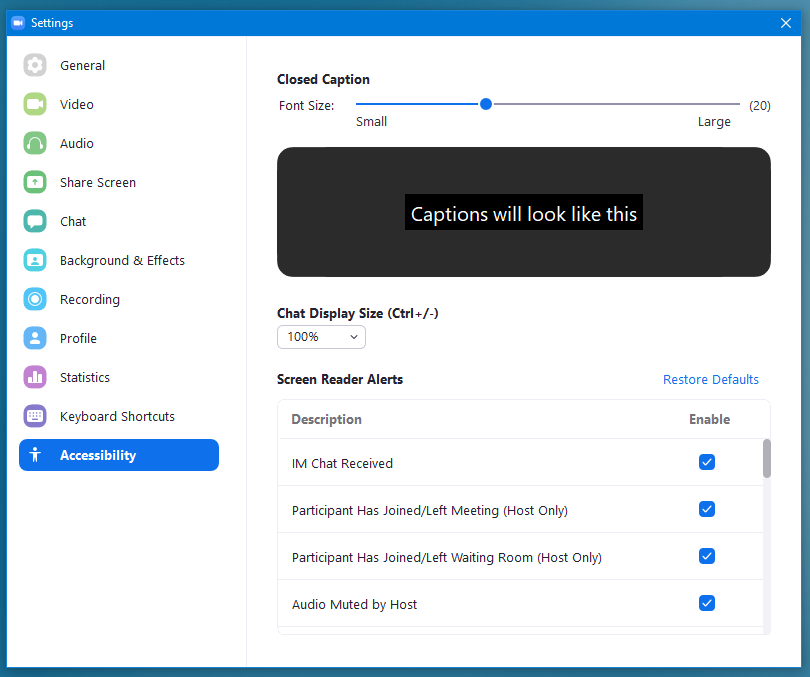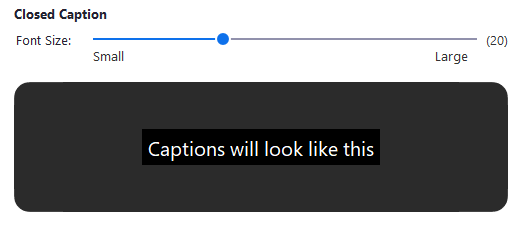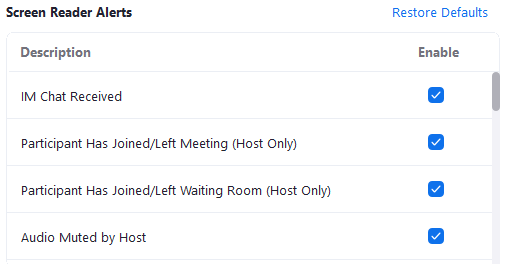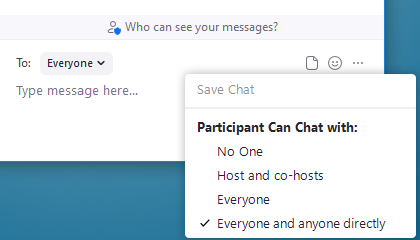Zoom Accessibility & Inclusivity
The following article discusses Zoom features that support access and inclusion. This includes closed captioning, font sizes, and audio notification sounds.
Live Transcript
Enabling Closed Captions in Zoom supports students with an auditory disability or language challenge. Zoom is able to translate audio to many text languages on the fly during a live Zoom meeting, using it's own AI translation engine. Where there are concerns about the potential for AI mistranslation it is also possible to assign a typist participant to caption instead. Where meetings are recorded, the live transcript can be downloaded after a Workshop or Tutorial in the form of a .VTT file, which can then be opened in a word processing application (e.g. Notepad).
To enable Close Captioning
- Click the CC icon on the Zoom toolbar to turn on live transcript.
- Ensure the language is set correctly.
- Zoom notifies participants that captioning has been enabled.
- Every participant can now click the CC button to turn the captions ON/OFF for them.
To enable a Manual Captioner
- Click on the Chevron arrow next to the CC icon on the Zoom toolbar and select Set Up Manual Captioner.
- Turn the Enable manual Captioner setting to On. Choose the Participant who will caption.
The short video below illustrates how these Zoom captioning features work.
Increased Accessibility Features
Zoom includes several additional settings that can support accessibility.
To access the Zoom accessibility settings
- Open the Zoom settings cog, located in the top right corner of the Zoom application.
- Click on Accessibility to access the settings.
- Increase the font size for closed captions to suit the student audience.
- Increase the Chat text size to suit the student audience.
- Under the Screen Reader Alerts heading set a chime or beep when the listed action occurs.
The following video provides a more detailed walk through of the Live Transcript settings along with other accessibility features in Zoom and how to change these settings during a meeting.The second half of this video discusses accessing and sharing recordings with transcripts, including using a searchable Live Transcript from a recorded meeting.
The Zoom Chat
Managing the Zoom chat effectively supports accessibility and inclusion. Where a large number of comments spam the chat, this can create confusion and overwhelm for other students. It may be necessary at times to disable the chat to curtail an inappropriate conversation, or redirect students focus. Don't forget that the Zoom Q&A tool can be used to manage student questions.
It is good practice to check the Zoom Chat settings located under In meeting (Basic), prior to starting a Zoom meeting. There are many options for managing the chat which include enabling/disabling chat saving, sharing files and moderating chat features.
During a Workshop or Tutorial, the Chat can be disabled or restricted in a number of ways during a meeting as illustrated in the following table.
| Setting | Function |
|---|---|
| No One | The Chat is locked and no one can use this function in a meeting |
| Hosts and co-hosts | Only the Host and the co-hosts can use the Chat function. It is locked for all other participants. Hosts will have access to the transcript if the chat is saved. |
| Everyone | All participants in the meeting can use the Chat, but all comments are public. All participants will have access to the transcript if the chat is saved. |
| Everyone and anyone directly | All participants in the meeting can use the Chat, and individuals can privately message any other individual during the meeting. All participants will have access to the transcript if the chat is saved, but private chats will only be visible to those who used them. |
To change the chat settings in a Zoom Meeting
- Ensure the Chat window is visible, by clicking on the Chat icon.
- Click the three dots in the bottom of the Chat box that appears.
- Choose from the appropriate drop down options.
- Students can also download the Chat conversation as a file by clicking on the Save Chat option (if enabled prior to the meeting).
The following video explains how the Zoom chat can be restricted during a meeting to support accessibility and inclusion.




